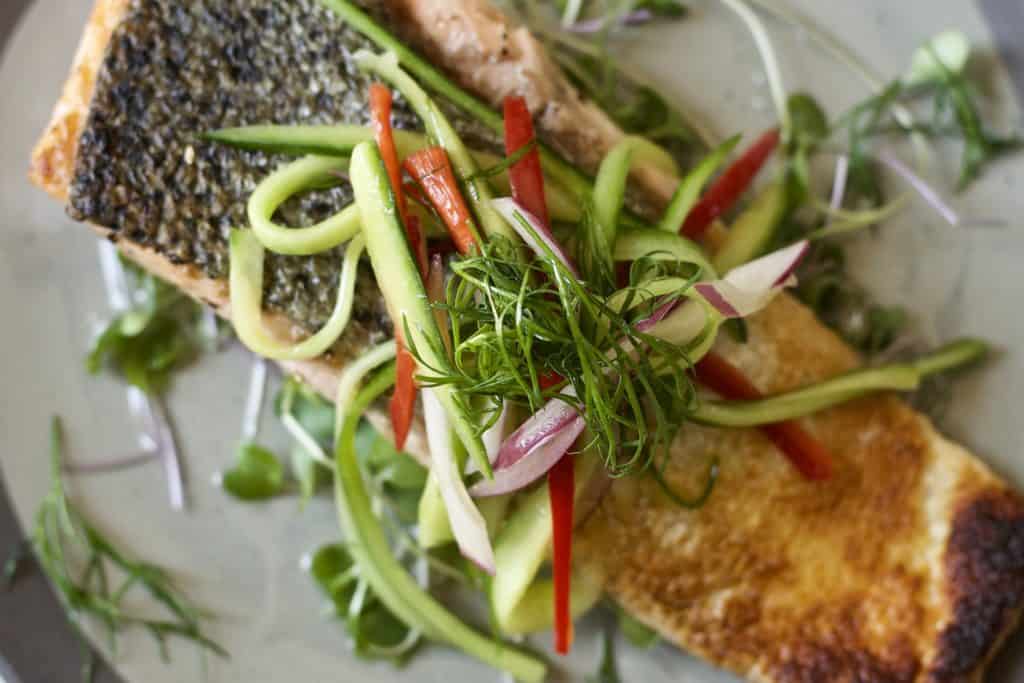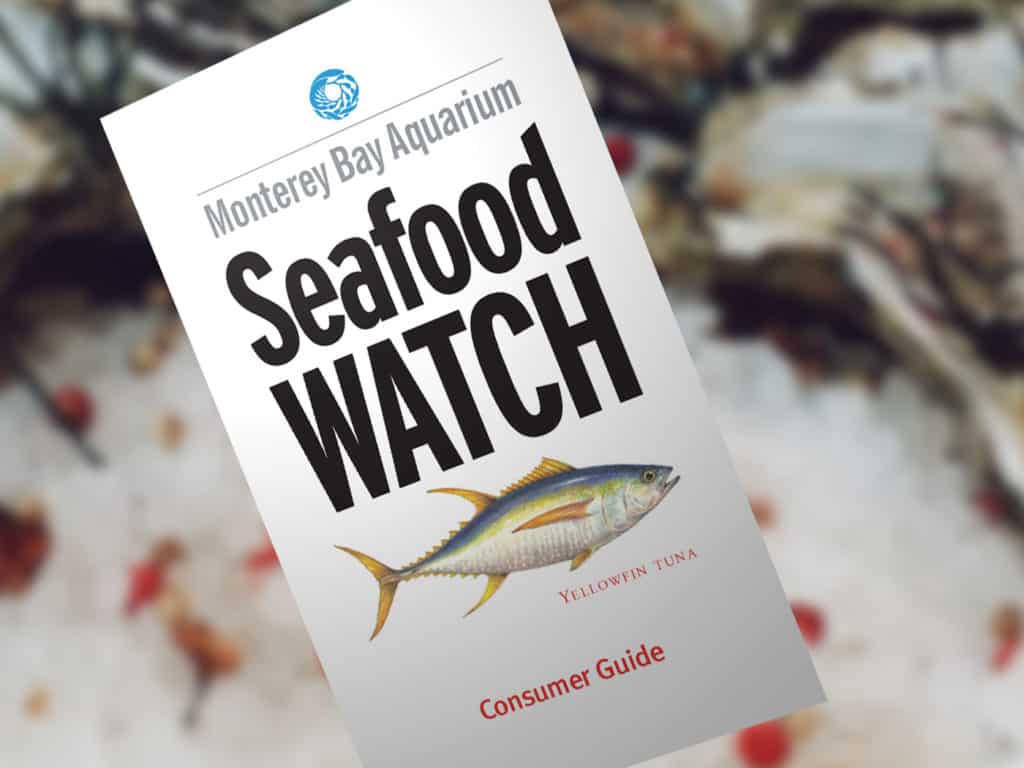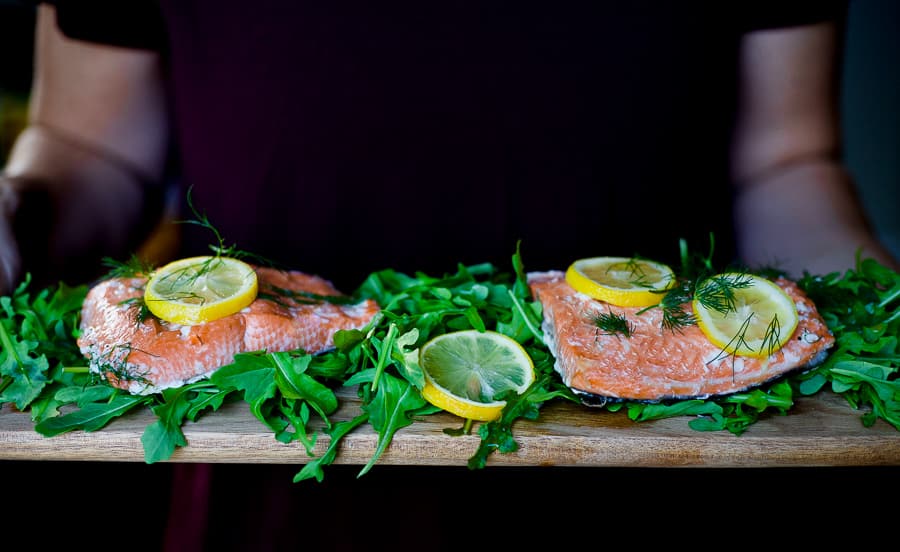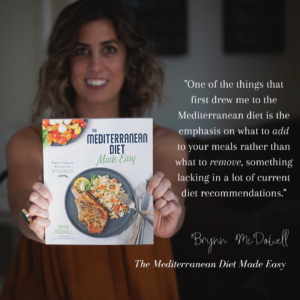Discussing the nutrition and health benefits of seafood as a focus of The Mediterranean Diet and as part of a healthy lifestyle.
Why I was Scared to Cook Fish at Home
Aside from tuna fish sandwiches, we hardly ever had fish growing up. I had very little experience eating it and none at all cooking it. It wasn’t until I became an adult and moved out on my own that I really started to try it.
I loved ordering salmon and scallops when out at a restaurant but was always too intimated to try and cook seafood at home. I had these visions of getting severely ill from undercooked seafood that I never even attempted it.
Then a friend came to visit and made us a delicious grilled salmon right in our own backyard. It was then that I realized I needed to start making more fish at home. So I learned more about it and now cook seafood about twice a week.
Current Seafood Recommendations

The Current Dietary Guidelines for Americans recommend 8oz or more of seafood a week, as part of a balanced diet. (Note – special recommendations for pregnant/breastfeeding women or young children discussed further below).
This typically equates to about 2 servings of seafood a week. The goal is to incorporate fish as the protein source in place of meat, poultry, or eggs at meals twice a week.
Nutrition & Health Benefits
Fish & Seafood is a great source of lean protein, low in saturated fat, a source of selenium, zinc, iodine and iron. Not to mention a natural source of B vitamins, Vitamin D and Vitamin A.
However, one of the biggest benefits of eating seafood are the Omega 3 Fatty Acids.
What are Omega 3 Fatty Acids?
Omega 3’s are essential fatty acids that are not produced in high enough amounts in the body. Therefore, we have to get them from dietary sources (i.e. food).
The 3 main Omega 3’s are – Eicosapentaenoic (EPA), Docsahexaenoic (DHA) and Alpha-Linolenic (AHA).
Seafood is the main source of DHA and EPA, while ALA comes from mostly plant sources like flaxseed and plant based oils like canola oil.
Your body has the ability to convert some ALA into DHA and EPA, but only in small amounts. Therefore, eating foods high in EPA and DHA are the recommended way to get these important Omega 3’s.
Why are Omega 3 Fatty Acids Important?
Research has shown that Omega 3 Fatty Acids have the ability to –
- Promote healthy brain and eye development in children
- Help build muscle and tissue
- Reduce the possible risk of heart disease
Sources of Omega 3 Fatty Acids
The American Heart Association recommends 1000 mg of EPA/DHA per day for patients with coronary heart disease, and two servings of oily fish per week for those without heart disease.
Not all fish have the same levels of Omega 3’s available though. Some of the highest levels of Omega 3’s can be found in –
- Salmon (like Wild King and canned pink)
- Mackerel
- Herring
- Tuna (wild, bluefin)
- Sardines (canned)
The Seafood Health Facts website has tons of great resources, handouts and information about seafood for consumers. This EPA + DHA Levels Chart is extremely helpful in showing the levels in common types of fish.
Mercury Levels in Fish

One of the biggest concerns for people concerning seafood is the mercury content found in fish.
All fish have trace amounts of mercury, but the levels vary widely. Typically, larger, older, predatory fish tend to have higher levels of mercury (shark, swordfish, large tuna (bluefin). Smaller fish with shorter live spans tend to have less mercury accumulation (sardines, skipjack tuna.
Some of the most popular seafood choices here in the U.S. are also low in mercury. These include salmon, sardines, pollock, flounders, cod, tilapia, shrimp, oysters, clams, scallops and crab.
For most of the population, the benefits of eating fish outweigh the risk associated with mercury/toxins.
Special Recommendations
There are special recommendations however for women that are trying to become pregnant, are pregnant and/or breastfeeding, and young children.
Mercury is toxic to brain development, making it a risk for pregnant women and young children. However, the Omega 3 fatty acids found in fish help aid brain development in children
- It is recommended that this population still eat about 8oz of a variety of seafood each week, especially those types high in EPA/DHA
- This population can safely eat up to 6oz of albacore (white) tuna a week
- Do not eat raw/partially cooked seafood
- Avoid shark, swordfish, king mackerel, or tilefish due to the high levels of mercury
Food Safety Tips
For those that are intimidated by handling or properly cooking fish, I completely understand as I used to feel the same way.
Once I became more confident and learned all the safe food handling techniques for fish, I now consider it one of the easiest things to cook at home.
This Seafood Safety Factsheet is a great resource if you are worried about cooking fish at home.
Seafood Sustainability

Sadly there is a decline in the wild fish populations, some of which is due to overfishing and our own consumption habits.
Seafood Sustainability is a movement that was started to help address and repair this issue. Sustainable Seafood means seafood that is either caught or farmed in ways that consider the long-term vitality of certain fish species, the safety of the oceans and the livelihood of fishery communities.
At my previous job in food service, our company policy was that we adhered to the Monterey Bay Aquarium Seafood Watch to only purchase and serve seafood that was on the “green” ocean friendly choice list.
As consumers, we can do the same thing on our own.
Download the Seafood Watch App on your phone to see which fish are currently on the sustainable list (it’s constantly updated and specific to the area you live in) or download a free printable consumer guide from seafoodwatch.org to show which types of fish are the “best choice”, “good alternatives” or fish to “avoid”.





Awesome read b. I live with you and still wanted to read all this
Thanks Dan, now you know why I always buy so much seafood.
Definitely something I need to start cooking more of. Thank you for the inspo!
Thanks so much for taking the time to read it and comment Kate.
I used to be scared of cooking fish, too! Thanks for this great post!
I love seafood and make sure to eat it twice a week! Great post!
Great post! I enjoy seafood, but my daughter doesn’t eat it (vegetarian) so I don’t cook it as often as I’d like too. She’s headed off to college this fall, so I’d love to experiment with more seafood recipes for myself, my hubby, and son. Thanks for sharing!
I don’t cook it for my daughter too often either because my son has an allergic reaction to seafood, so I typically save it for meals my husband and i eat together but I’ve got to be better at making some for her too
Loved this post, Brynn! I’m totally intimidated by cooking certain types of fish, but appreciate all the reminders of why it’s important and will definitely be making more!
Such a great overview to get more fish into the American diet!
[…] can read about The Health Benefits of Seafood […]
Wow, I never knew that seafood is the main source of DHA and EPA which I’ll need for a healthier body. Perhaps I should eat some of that, and since I haven’t tried southern-style food yet, I might go to a restaurant that serves them. I’ve heard that southern-style food has a unique taste to it, but I never got the chance to try it for myself since I’m not sure which recipes are true to its taste, but if I ever get to taste it, I might try to include it in my regular diet.
[…] free to read more about the Health Benefits of Seafood […]
[…] Check out more detailed info here – Health Benefits of Seafood […]
[…] You may learn extra about The Health Benefits of Seafood. […]
[…] You can read more about The Health Benefits of Seafood. […]
I like that you pointed out how fish and seafood is a great source of lean protein, low in saturated fat, a source of selenium, zinc, iodine and iron. My family is planning to eat out this Friday and we are looking for a good place for it. Eating healthy would be nice since some of us got certain health conditions, so I am thinking of going to a late night seafood restaurant.
[…] […]
[…] a look at extra on the Well being Advantages of Seafood or discover inspiration right here – 55 Wholesome Fish […]